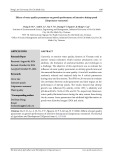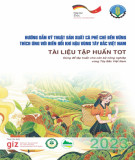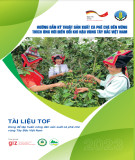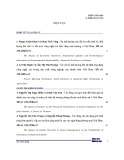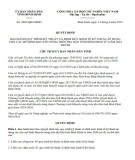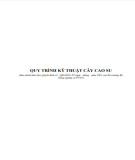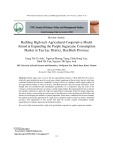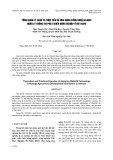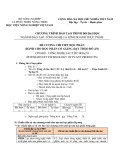
Vietnam Journal
of Agricultural
Sciences
ISSN 2588-1299
VJAS 2023; 6(3): 1873-1882
https://doi.org/10.31817/vjas.2023.6.3.05
1873
Vietnam Journal of Agricultural Sciences
Received: July 7,
2022
Accepted: September 13, 2023
Correspondence to
debbiecosrojas@gmail.com
Product Flow and Challenges in the Pomelo
(Citrus maxima) Industry in Northern
Mindanao, Philippines
Karen Debbie J. Cosrojas1, Gretchen G. Abao1 & Analou D.
Piquero2
1Faculty, Central Mindanao University, Musuan, Maramag, Bukidnon, 8714, Philippines;
2Research Aide, Central Mindanao University, Musuan, Maramag, Bukidnon, 8714,
Philippines;
Abstract
The high demand for Davao pomelo and its suitability to the local
climate in the Philippines have given rise to expansion potentials and
provided possibilities in curbing poverty levels in the agricultural
sector of the region. In order to design intervention projects and
policies, the present study investigated the pomelo industry in
Northern Mindanao covering specifically the product flow and
challenges in the industry. The study area was four provinces of
Northern Mindanao, namely Bukidnon, Lanao del Norte, Misamis
Occidental, and Misamis Oriental. The data were gathered using a
semi-structured questionnaire with 22 respondents composed of 9
pomelo producers and 13 traders. The majority of the pomelo
products that were sold in the markets in Northern Mindanao come
from outside the region, such as Davao and Cotabato provinces, while
pomelo produced in the region were sold outside the region. Among
the three marketing chains of pomelo, the producer to consumer is
considered the most efficient chain based on the estimated losses.
Challenges in the pomelo industry include the lack of technical
knowledge among the producers, poor quality of the pomelo, high
buying price, and information asymmetry. Improvement in the
industry could be enhanced by addressing the challenges identified.
Keywords
Pomelo marketing, marketing chain, supply chain
Introduction
Pomelo (Citrus maxima) is a citrus fruit native to Malaysia and
South East Asia. It is extensively grown in the Philippines because it
is widely adapted to local soil and climatic conditions.
The last
available information on the production of pomelo in the Philippines
was reported in the study of Pangan and Alaba in 2008 entitled “Supply
Chain of Pomelo in Davao Region”. Shown in their report was the

Product flow and challenges in the pomelo (Citrus maxima) industry in Northern Mindanao, Philippines
1874
Vietnam Journal of Agricultural Sciences
comparison of pomelo production among
different regions in the country as well as the
comparison of pomelo production from different
provinces in the Davao region. They also
reported that the Philippine’s pomelo production
experienced an average decline of 3% (Pangan &
Alaba, 2008). Issues that have been identified in
pomelo production include low profitability, land
conversion or crop shifting, lack of institutional
support to motivate and encourage pomelo
farmers, non-adoption of good agricultural
practices, improper insect pest management to
promote farm productivity, and poor post-harvest
facilities and product handling (Patayon, 2018).
Additionally, control of the citrus rind borer as
the major insect pest for pomelo, which claims
around 60% to 80% (Gavarra, 1988) of the entire
produce, might still be affecting the commercial
productivity of pomelo farmers.
In terms of marketing pomelo, Pangan and
Alaba (2008) reported about the high marketing
margin of middlemen in the pomelo supply
chains making the fruit’s price highly sensitive to
its supply. They documented high product losses
ranging from 30% to 50% that were experienced
during the handling activities of middlemen such
as wholesalers while minimal losses of around
5% were experienced by the retailers. These
findings in 2008 were indications of existing
problems and issues surrounding the different
channels and nodes in the pomelo supply chain,
which directly affect the fruit’s retail price.
Although pomelo is faced with production
and marketing constraints, there is still a huge
potential of the commodity. Lustria et al. as cited
by Radores et al. (2021) reported that the
Philippines exported pomelo in 1999-2001, but
due to increasing domestic consumer demand,
the country began importing pomelo from other
countries. This demand is a window for
expansion potentials which would provide
possibilities in alleviating poverty in the region.
In order to identify the areas for improvement on
these possible potentials, there is a need to assess
the industry in the region and update the
literature on the status of the pomelo industry in
the region, hence, this study.
The present study aimed to trace the product
flow of pomelo and determine its challenges.
Product flow included the movement of goods
from the supplier to the customer, as well as any
customer returns or service needs. Analysis of
this flow helped to identify the key players, peso
share of each player, volume of pomelo handled,
the average selling price, estimated losses, and
the modes of payment. Further, this paper
identifies the challenges in the pomelo industry
at the farmer and traders’ levels. These are vital
pieces of information in the pomelo industry in
the region, which may become the basis for
crafting intervention initiatives in the
improvement of the industry.
Methodology
Study area, sampling, and methods
The research study covered four provinces in
Northern Mindanao, namely Bukidnon, Misamis
Oriental, Misamis Occidental, and Lanao del
Norte. Northern Mindanao is located in the
southern part of the Philippines. Figure 1
presents a map of Northern Mindanao
highlighting the four provinces of the study site,
and the locations of the producers and traders.
Enclosed in the green rectangle are the provinces
in the region. The producers are located in
Quezon, Bukidnon; Alubijid, Misamis Oriental;
and Baliangao, Misamis Occidental. Areas
outside the green rectangle are sources of pomelo
coming from outside the region, including
Cotabato City and Davao City.
The pomelo producers and traders in the said
areas were the respondents of the study who were
selected using purposive sampling. This is a non-
probability sampling method where the elements
selected for the sample are chosen by the
judgment of the researchers (Black, 2010).
Farmer respondents were selected from the
recommendations of the city or the municipal
agriculture office in the areas while trader
respondents were selected based on their
availability and willingness to provide
information during data gathering.
The study employed the interview method in
data collection. Interviewing is a method of data
collection that involves two or more people

Karen Debbie J. Cosrojas et al. (2023)
https://vjas.vnua.edu.vn/
1875
exchanging information through a series of
questions and answers (DeCarlo, 2018). The
questions were designed by the researchers
following the objectives of the study.
A total of 22 respondents were interviewed
using a pre-structured questionnaire. There were
9 pomelo producers and 13 traders who were
interviewed. Most of the pomelo producers were
located in Misamis Occidental, particularly in the
municipality of Baliangao. The traders included
six wholesaler-retailers and seven retailers. The
number of respondents was the available
recipients at the time of data gathering. In
addition, the researchers were constrained by
travel restrictions because of the COVID-19
pandemic at the time of the data gathering, hence,
the smaller sample size. The interviews among
the respondents were conducted from July to
October 2021, which was still during the height
of the COVID-19 pandemic in the region.
Data collection and data analysis
Primary data were gathered through a semi-
structured questionnaire, which was pre-tested
for the purpose. The questionnaire was designed
in such a way that it captured the qualitative
information needed in order to learn about the
product flow and challenges of the pomelo
industry. Product flow covered the geographical
flow and the key players of pomelo production
and distribution across the region. The
challenges were the issues and concerns
identified as pomelo flows from the point of
production to the point of last sale. The data were
presented in Figures and Tables, and were
discussed accordingly.
Results and Discussion
Product flow of pomelo
The pomelo product flow illustrates the
movement of pomelo from the point of
production to the point of consumption. It
exemplifies the different players involved and
their geographical locations, volume handled,
peso share of each player, average selling price,
estimated losses, and the mode of payment.
Figure 2 presents the flow of pomelo from
the farmers located within the region to traders
outside the region. One farmer was located in
Figure 1. Study sites in Northern Mindanao. (Source: Map modified from Google)

Product flow and challenges in the pomelo (Citrus maxima) industry in Northern Mindanao, Philippines
1876
Vietnam Journal of Agricultural Sciences
Figure 2. Product Flow of Pomelo from Farmers in Northern Mindanao
Quezon, Bukidnon, one was from Alubijid,
Misamis Oriental, and seven were from
Baliangao, Misamis Occidental.
In Bukidnon, all the pomelos produced by
the farmer were sold to a trader from Mlang,
Cotabato and/or Calinan, Davao City, whoever
happens to contact the farmer first and negotiate.
It should be noted that “buyer” is the term used
for traders outside the region since the
researchers were not able to interview them
because their locations were not covered by the
study. Hence, their roles were not ascertained.
The buyers from outside the region were those
who went to the farm to pay for the harvesting,
sorting, and grading, and buy all the produce,
including the rejected ones. The farmer was able
to sell 3700kg of pomelo in one cropping season.
This was the only farmer who had two cropping
seasons each year. Pomelos classified as Class A
and B are priced higher while rejected pomelos
are priced lower. Selling to the said buyers was
more convenient for the farmer because he would
no longer incur additional costs for the
harvesting and would be able to save time
looking for buyers for his produce.
The sole producer of pomelo in Misamis
Oriental practiced online selling directly to the
consumers at a volume of 1100kg while a smaller
volume of around 400kg was sold to retailers in
the nearby barangays who came to his farm. The
farmer found it convenient to sell the pomelo
online because of travel restrictions due to the
Covid-19 pandemic. Further, the farmer was able
to set the price and sell pomelo given the market
prevailing price in the area.
Further, the pomelos produced from the
province of Misamis Occidental were mostly
marketed outside of the region, such as Bohol,
Cebu, Dumaguete, and Zamboanga Peninsula.
The “Pakyaw” (all-in) system through eyeball
estimates was the common buying practice in the
province. Some farmers reported a volume of
1600kg to 5000kg yield per hectare year although
some did not know the volume they produced
because of the “pakyaw” system. Many buyers
from different provinces travelled to the farms to
negotiate and bid their price. Farmers then had
the option to sell their produce to the highest
bidder. Pomelos that were brought by traders
from Bohol, Cebu, and Dumaguete were
subsequently transported via the Plaridel seaport
in Plaridel, Misamis Occidental. The low-quality
or the rejected pomelos were then sold in the
locality at a very low price.
Figure 3 presents the product flow of
pomelo coming from outside the region. The
volumes shown in the figure are the volumes
handled by the traders for their single

Karen Debbie J. Cosrojas et al. (2023)
https://vjas.vnua.edu.vn/
1877
transactions with sellers from the source. These
transactions happened once or twice a month.
The majority of the pomelo products that
were sold in the local markets within Northern
Mindanao came from outside the region such as
Davao and Cotabato provinces. The wholesaler-
retailers located in Bukidnon, Lanao del Norte,
and Misamis Oriental provinces transacted
with the so called “handlers” or “disers” in
Davao or Cotabato and not directly with the
farmers. The handlers facilitated the trading of
pomelo outside the region, hence, traders from
Northern Mindanao could not penetrate the
farm to do transactions directly with the
farmers. Some of these handlers were the
ambulant sellers who also delivered pomelo to
different wholesaler-retailers or retailers in the
region, which usually happened during the
peak harvest season of the commodity.
The wholesaler-retailer in Bukidnon
procured around 1500kg of pomelo from the
suppliers in Davao or Cotabato where half
(750kg) of this volume was sold to retailers in the
province and the other half was sold to
consumers. This wholesaler-retailer went to
Davao or Cotabato to procure pomelo and was
the one who shouldered the labor and
transportation costs for the acquisition.
Meanwhile, the wholesaler-retailers from
Lanao del Norte also sourced out pomelo
products from the Davao and Cotabato regions.
They went directly to a bagsakan (drop-off point
for fruits and vegetables) point in Davao and
Cotabato or waited for a handler to deliver the
pomelo to them. The ones who went to the drop-
off points were also trading fruits other than
pomelo such as durian. The wholesaler-retailer
sold 1000 to 2000kg of pomelo to the retailers
located in Iligan City, Lanao del Norte, and
Marawi City, Lanao del Sur, and around 500kg
of the volume they handled was sold to the
consumers. On the other hand, some retailers in
Lanao del Norte sourced out pomelo from the
Davao region via Sultan Naga Dimaporo, Lanao
del Norte Road while others waited for the
ambulant seller from Davao to deliver to their
respective stalls.
Furthermore, a huge wholesaler-retailer in
Cagayan de Oro City, who also sourced their
pomelo from Cotabato or Davao, supplied
pomelo to the huge supermarkets in the region
like Robinsons Supermarket and to other retailers
around Northern Mindanao. The wholesaler-
retailer would buy around 2500kg of pomelo per
Figure 3. Product Flow of Pomelo from Outside Northern Mindanao


